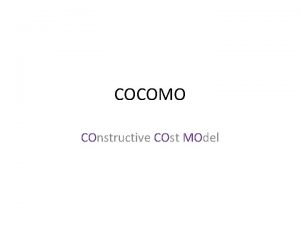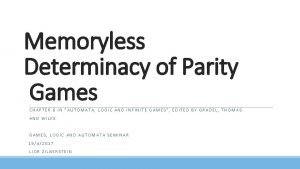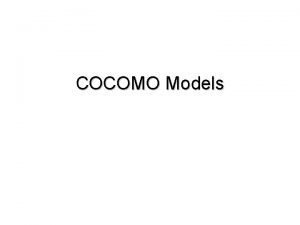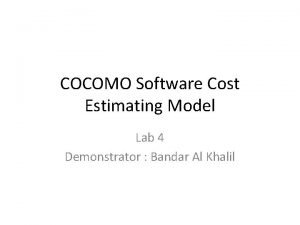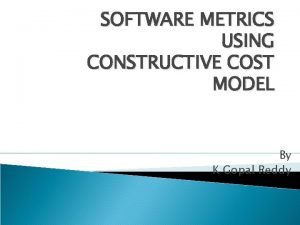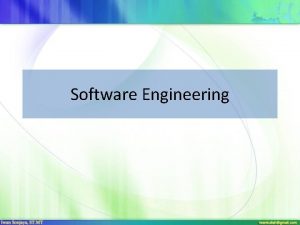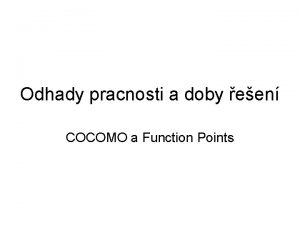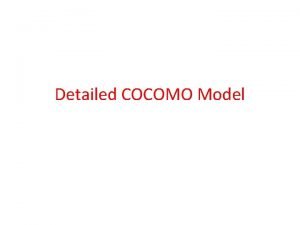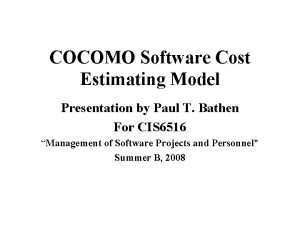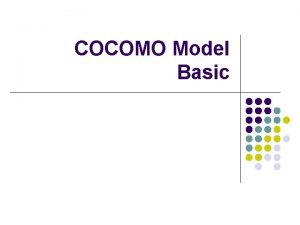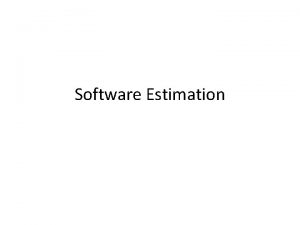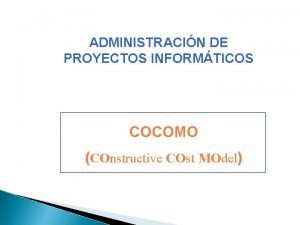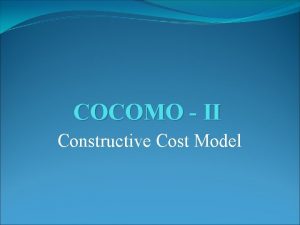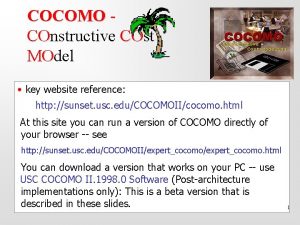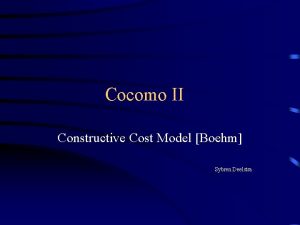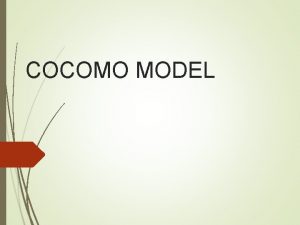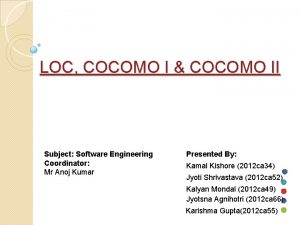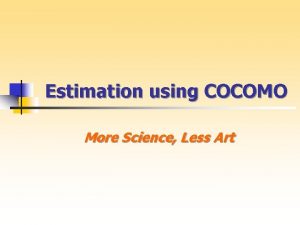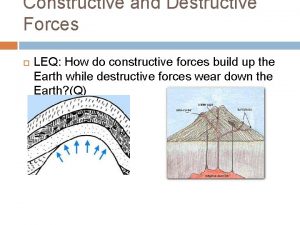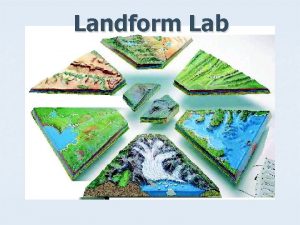COCOMO COnstructive COst MOdel COCOMO The COstructive COst



















- Slides: 19

COCOMO COnstructive COst MOdel

COCOMO • The COstructive COst MOdel (COCOMO) is the most widely used software estimation model in the world. • The COCOMO model predicts the effort and duration of a project based on inputs relating to the size of the resulting systems and a number of "cost drives" that affect productivity.

COCOMO • As per Boehm, 1981 software development project can be classified into three categories based on development complexity: – Organic (Applications -> data processing programs) • A well-understood application program – Semidetached (Utilities -> compiler, linkers etc) and • Experienced and inexperienced staff – Embedded (System programs -> OS, real-time system programs) • Software, to be developed is strongly coupled with complex hardware • To classify a project one need to know – Characteristic of product, development team and development environment


Basic Model • Basic COCOMO model takes the form • where E is effort applied in Person-Months, and D is the development time in months. The coefficients ab, bb, cb and db are given in table on next slide.


• When effort and development time are known, the average staff size to complete the project may be calculated as: • When project size is known, the productivity level may be calculated as:

Example • Suppose that a project was estimated to be 400 KLOC. Calculate the effort and development time for each of the three modes i. e. , organic, semidetached and embedded.

Solution • The basic COCOMO equation take the form: E = ab (KLOC)bb D = cb (E)db Estimated size of the project = 400 KLOC (i) Organic mode E = 2. 4(400)1. 05 = 1295. 31 PM D = 2. 5(1295. 31)0. 38 = 38. 07 PM (ii) Semidetached mode E = 3. 0(400)1. 12 = 2462. 79 PM D = 2. 5(2462. 79)0. 35 = 38. 45 PM (iii) Embedded mode E = 3. 6(400)1. 20 = 4772. 81 PM D = 2. 5(4772. 8)0. 32 = 38 PM

Exercise • A project size of 200 KLOC is to be developed. Software development team has average experience on similar type of projects. The project schedule is not very tight. Calculate the effort, development time, average staff size and productivity of the project.

Solution • The semi-detached mode is the most appropriate mode; keeping in view the size, schedule and experience of the development team. Hence, E = 3. 0(200)1. 12 = 1133. 12 PM D = 2. 5(1133. 12)0. 35 = 29. 3 PM = 1133. 12/29. 3 = 38. 67 persons

Productivity = KLOC/E = 200/1133. 12 = 0. 1768 KLOC/ PM P =176 LOC / PM

Intermediate Model According to COCOMO, the major productivity drivers include: • Product attributes: required reliability, database size, product complexity • Computer attributes: execution time constraints, storage constraints, virtual machine (VM) volatility, turnabout time • Personnel attributes: analyst capability, application experience, VM experience, programming language experience • Project attributes: modern programming practices, software tools, schedule constraints

Software Project Planning Multipliers of different cost drivers Cost Drivers RATINGS Very low Low Nominal High Very high Extra high 0. 75 0. 88 1. 00 1. 15 1. 40 -- DATA -- 0. 94 1. 00 1. 08 1. 16 -- CPLX 0. 70 0. 85 1. 00 1. 15 1. 30 1. 65 TIME -- -- 1. 00 1. 11 1. 30 1. 66 STOR -- -- 1. 00 1. 06 1. 21 1. 56 VIRT -- 0. 87 1. 00 1. 15 1. 30 -- TURN -- 0. 87 1. 00 1. 07 1. 15 -- Product Attributes RELY Computer Attributes 14

Software Project Planning Cost Drivers RATINGS Very low Low Nominal High Very high Extra high 1. 46 1. 19 1. 00 0. 86 0. 71 -- 1. 29 1. 13 1. 00 0. 91 0. 82 -- 1. 42 1. 17 1. 00 0. 86 0. 70 -- 1. 21 1. 10 1. 00 0. 90 -- -- 1. 14 1. 07 1. 00 0. 95 -- -- 1. 24 1. 10 1. 00 0. 91 0. 82 -- 1. 24 1. 10 1. 00 0. 91 0. 83 -- 1. 23 1. 08 1. 00 1. 04 1. 10 -- Personnel Attributes ACAP AEXP PCAP VMEXP LEXP Project Attributes MODP TOOL SCED Multiplier values for effort calculations 15

• Intermediate COCOMO equations EAF: effort adjustment factor 16

Example • A new project with estimated 400 KLOC embedded system has to be developed. Project manager has a choice of hiring from two pools of developers: Very highly capable (lot of application experience) with very little experience in the programming language being used • Or • Developers of low quality (very less application experience) but a lot of experience with the programming language. • What is the impact of hiring all developers from one or the other pool ?

Solution • This is the case of embedded mode and model is intermediate COCOMO. Hence, = 2. 8(400)1. 20 = 3712 PM • Case I: Developers are very highly capable with very little experience in the programming being used. EAF = 0. 82 x 1. 14 = 0. 9348 E = 3712 x. 9348 = 3470 PM D = 2. 5 (3470)0. 32 = 33. 9 M

• Case II: Developers are of low quality but lot of experience with the programming language being used. EAF = 1. 29 x 0. 95 = 1. 22 E = 3712 x 1. 22 = 4528 PM D = 2. 5 (4528)0. 32 = 36. 9 M
 Suppose a project was estimated to be 400 kloc
Suppose a project was estimated to be 400 kloc Constructive proof vs non constructive
Constructive proof vs non constructive Constructive proof vs non constructive
Constructive proof vs non constructive Constructive proof vs non constructive
Constructive proof vs non constructive Constructive proof vs non constructive
Constructive proof vs non constructive Project size
Project size Cocomo cost estimation model
Cocomo cost estimation model Cocomo is not a perfect realistic model
Cocomo is not a perfect realistic model Constructive cost model
Constructive cost model Software pro odhadování
Software pro odhadování Cocomo 2 formula
Cocomo 2 formula Cocomo model calculator
Cocomo model calculator Image alignment
Image alignment Hình ảnh bộ gõ cơ thể búng tay
Hình ảnh bộ gõ cơ thể búng tay Lp html
Lp html Bổ thể
Bổ thể Tỉ lệ cơ thể trẻ em
Tỉ lệ cơ thể trẻ em Voi kéo gỗ như thế nào
Voi kéo gỗ như thế nào Tư thế worm breton là gì
Tư thế worm breton là gì Chúa yêu trần thế alleluia
Chúa yêu trần thế alleluia
